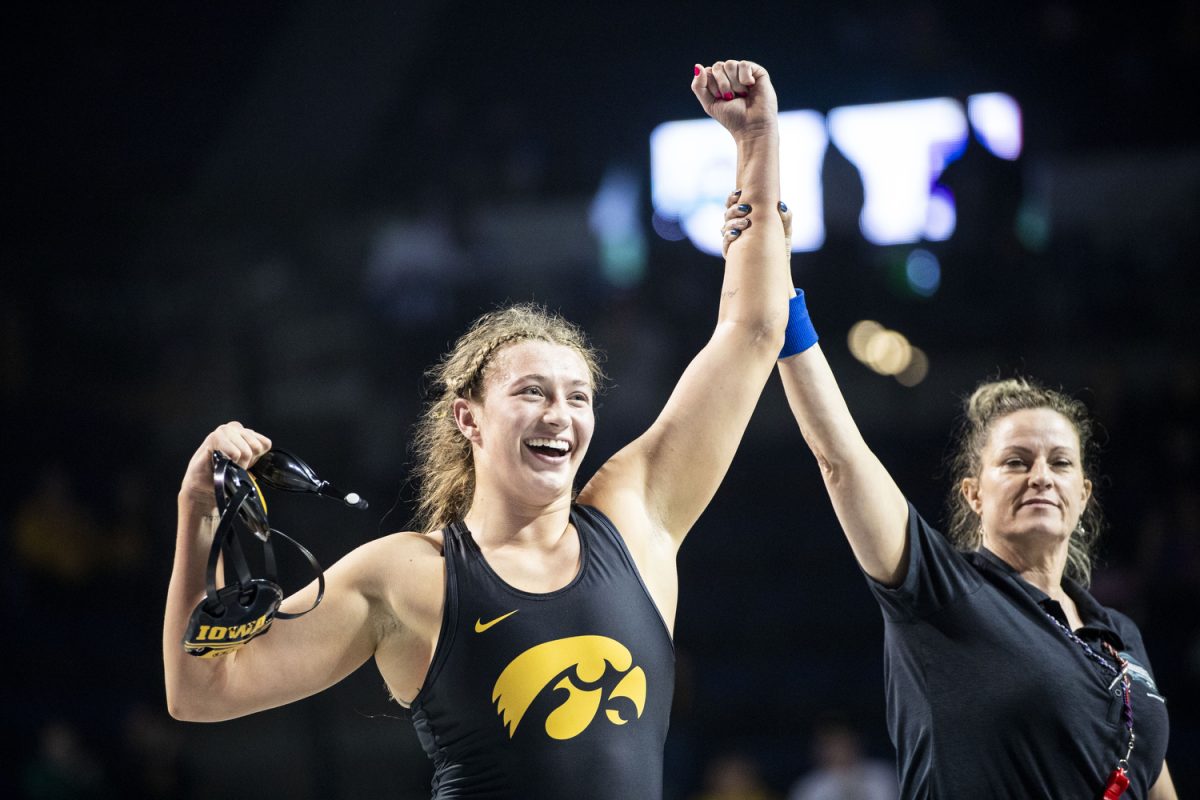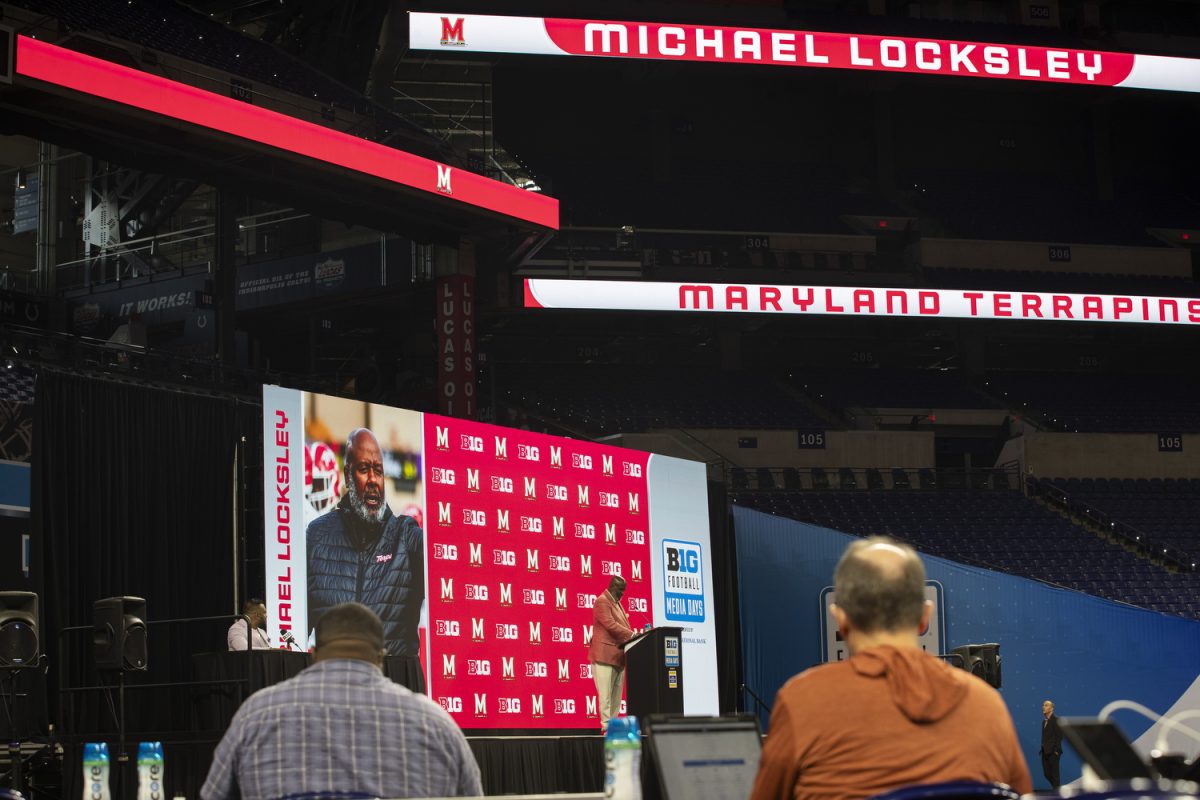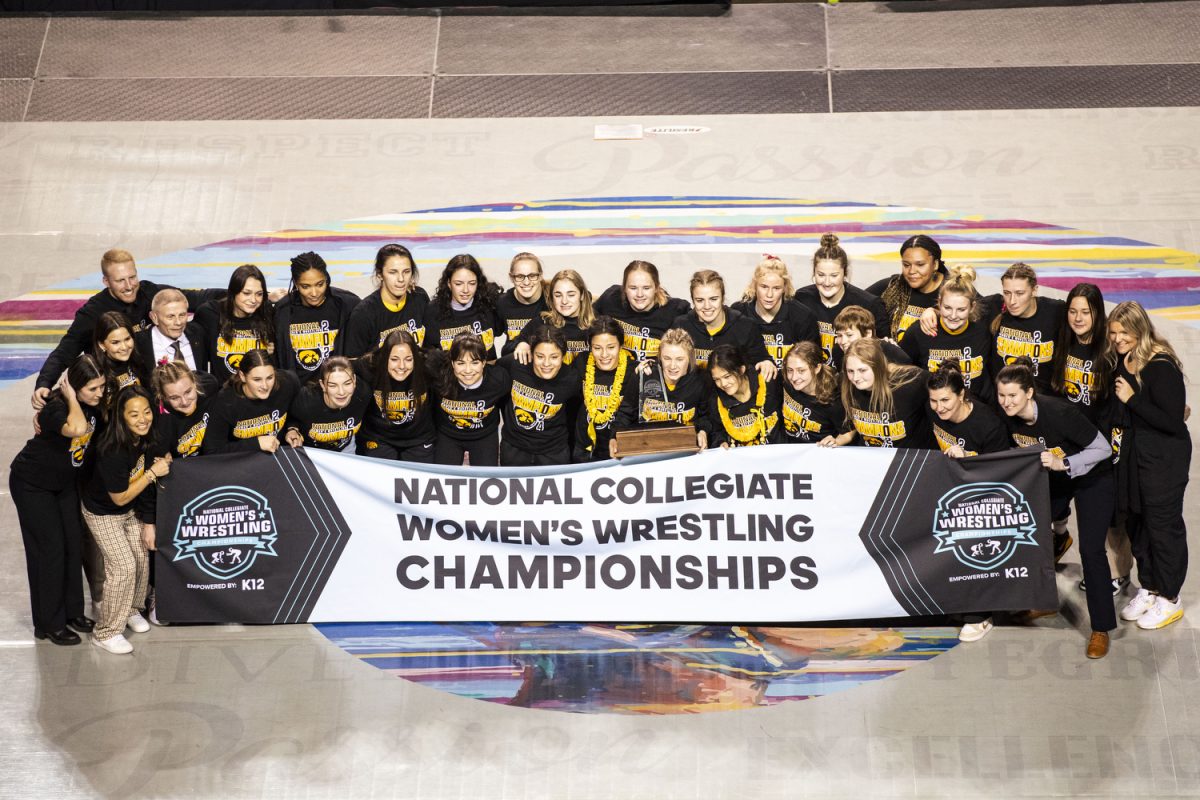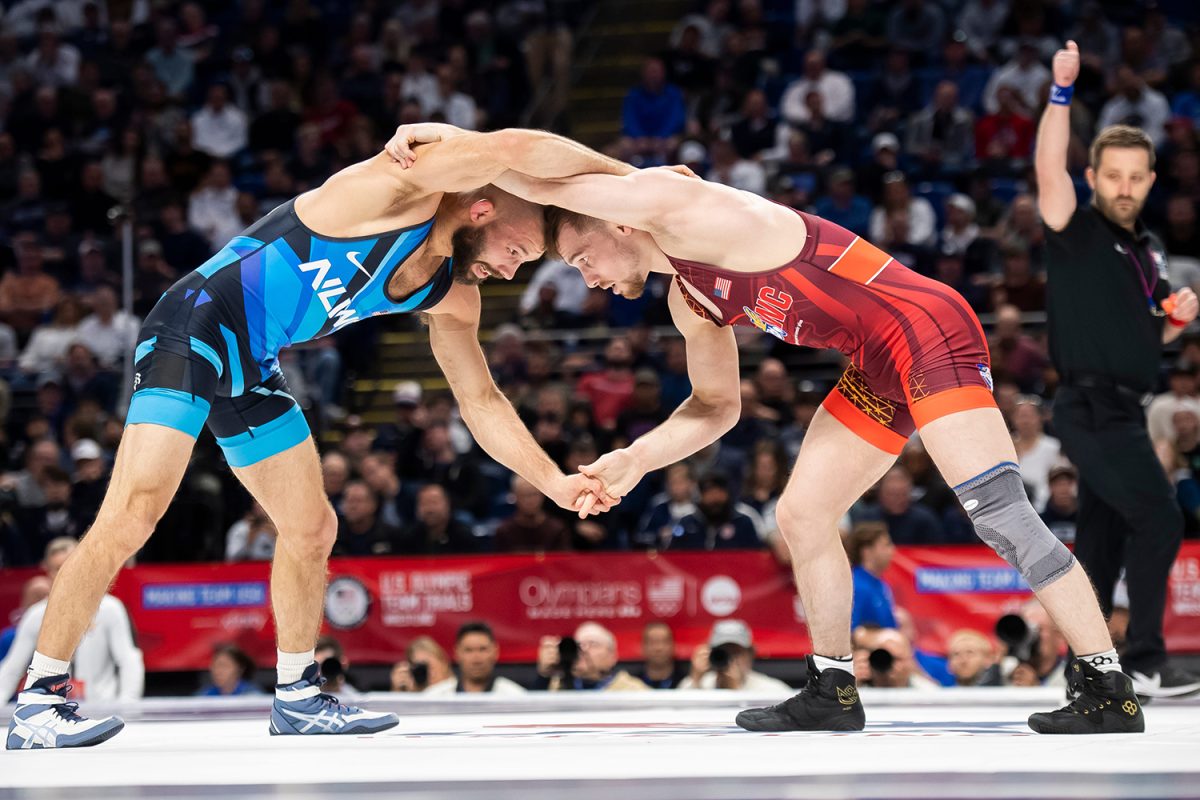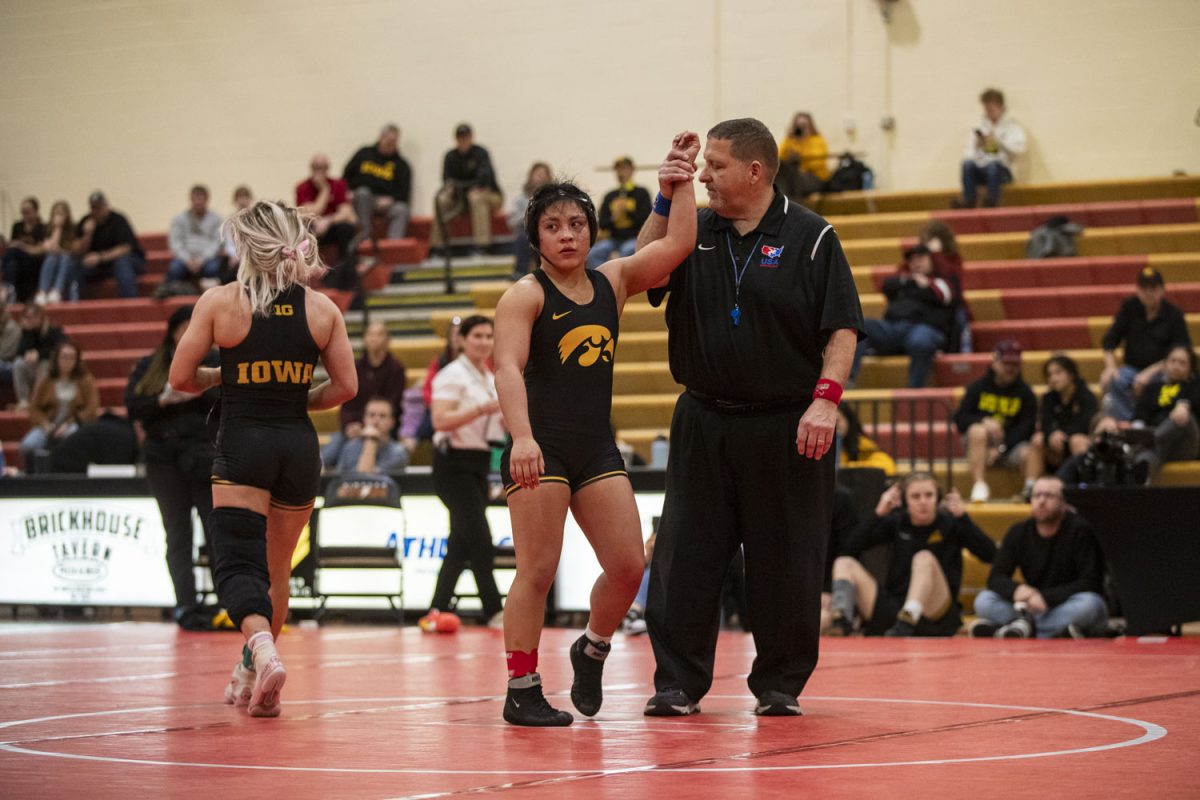For centuries, the pressure to “make weight” has been a norm in wrestling.
The number on the scale determines one’s ability to compete and live out their dream on the mat. Weighing in an ounce over the athlete’s specified weight class on meet day is all it takes to impede a wrestler from competition. However, focusing too much on what the scale says can be detrimental to an athlete’s physical and mental well-being.
That’s why you won’t hear anyone use the term “cutting weight” inside the Iowa women’s wrestling room. Instead, head coach Clarissa Chun and staff preach weight management.
“Our coaches are huge advocates for not cutting weight, or, you know, losing an absurd amount of weight to compete,” Iowa women’s wrestler Kylie Welker said. “We have nutritionists, we can meet with psychologists, like, all of those kinds of resources, which is nice.”
Ella Schmit, a 143-pounder on the Iowa roster, said she and her Hawkeye teammates compete in the range of five percent of their body weight and “keep that under control the whole season.”
Welker said the Iowa coaches are “straightforward” with their policies around weight management. If an athlete is too heavy or their weight is out of control “to the point where it would be considered dangerous,” Welker said the coaches will pull the wrestler aside and have a one-on-one conversation.
Across the state border in Illinois, staff at North Central College have instilled the same mindset into their women’s wrestlers, staying away from the term “cutting weight.”
Cardinal head wrestling coach Joe Norton said every wrestler in their lineup last season — besides a 101-pounder who was already at the lowest allowable weight per NCAA rules — was competing at least one weight class above their minimum wrestling weight.
“We’d like them to just come in and be big and strong and feeling good and coming in focused on developing and getting better at wrestling instead of focusing on losing weight,” Norton said.
After three wrestlers died in 1997 within 32 days of one another because of dangerous weight loss practices, the NCAA enacted today’s current rules. There is a weight certification process that every wrestler must go through before the season starts. This includes a bodyweight assessment, a urine-specific gravity test to confirm a hydrated state, and a body composition test.
According to the NCAA, the primary purpose of the weight certification program is to “assist wrestlers in determining the weight class that is best for them.” Athletes will also receive a personal weight loss descent plan to follow if needed. The NCAA states a wrestler cannot lose more than 1.5 percent of their weight per week.
The NCAA’s minimum body fat percentage requirements are 5 percent for men and 12 percent for women. After much debate if 12 percent minimum body fat is too low for women, Norton said next season the minimum body fat percentage is moving to 17 percent, so, “by law, girls won’t be allowed to cut as much weight even if they wanted to.”
Physician Andy Peterson, who specializes in pediatrics and sports medicine and takes care of men’s and women’s wrestlers at Iowa, told USA Today in March that the general rule high school wrestlers follow is a minimum 7 percent body fat percentage for boys and 14 percent for girls.
Women naturally store more body fat than men, so having too low of body fat can cause an athlete to experience the female athlete triad — a complex disorder first coined by the American College of Sports Medicine in 1992. This disorder involves menstrual dysfunction, low energy availability, and decreased bone mineral density, or BMD.
Emma Calow, a visiting assistant professor in the UI’s Sports Media and Culture Program, was a former elite badminton player and now looks at the sociocultural studies of women in sports.
“As an elite athlete, I developed an eating disorder. My periods stopped. I was on the brink of hospitalization. I just was not eating and was deeply unhappy,” Calow said. “But for me, how that came about was the people around me, my coach, my trainer, they were all men, who perhaps weren’t really cognizant of what it was like to be a female in this sporting space. And this is not me pointing fingers at men in the sport. This is not me saying you’re at fault, but this is me pointing fingers at the system in which we all operate on, a system that primarily prioritizes one’s performance over the actual person.”
Welker said she wishes more people would realize the “difference between the female side and the male side of weight management.” Welker said she knows men’s wrestlers who will lose eight to 10 pounds during practice, and she loses two to three pounds “on a good day.”
NCAA rules also prohibit the following “unsafe practices”: use of vapor-impermeable suits and similar devices, saunas, hot boxes, steam rooms, laxatives, emetics, excessive food and fluid restriction, self-induced vomiting, diuretics, use of any artificial means of rehydration, and wrestling room temperatures higher than 80 degrees.
The Center of Disease Control and Prevention said the three wrestlers who died in 1997 each “restricted food and fluid intake and attempted to maximize sweat losses by wearing vapor-impermeable suits under cotton warm-up suits and exercising vigorously in hot environments.”
‘The worst part of the sport’
Welker, who deems herself a strong advocate for not cutting weight, has felt the direct impacts that rapid weight loss can have on an athlete.
When Welker was in high school, she cut from 160 to 136 pounds. She was forcing herself to work out four times a day and water loading, drinking double her body weight in ounces up until a day before weigh-ins.
She was physically and mentally drained, and her focus at practice was to see how much weight she could lose instead of perfecting her craft. Welker’s passion for the sport was quickly fading.
“It was a huge toll mentally and physically, especially during that age because your bodies are changing during that time,” Welker said. “For you to be limiting yourself from food and all that stuff, it really changes you.”
Heading into the 2021 Last Chance U.S. Olympic Trials Qualifier, Welker decided to bump up a weight class and compete at 68 kg — the equivalent of about 150 pounds. She qualified for the Olympic Trials and then bumped up another weight class to 76 kg, or about 167 pounds.
As draining as cutting weight was, gaining it wasn’t a smooth transition either for Welker.
“It was still hard for me because mentally I would put a number on different items of food like, ‘Oh, this food weighs this much or this food weighs this much,’” Welker said.
She ended up winning the challenge tournament at 76 kg at the Olympic Trials, eventually falling in the best-of-three championship series to five-time World champion and two-time Olympian Adeline Gray. At 17 years old, Welker was selected as the U.S. Olympic alternate.
Since making the jump to 76 kg, a more natural and healthier weight for Welker, she said she has “not cut a single pound.” In March, Welker won the 170-pound national championship and clinched the team title for the Hawkeyes in their inaugural season. Norton’s squad at North Central College finished second in the nation.
Schmit has a similar story, as she said she started having more success on the mat as soon as she “stopped taking [cutting weight] so seriously.”
“I’ve fallen in love with the sport all over again because I don’t have to do that,” Welker said of cutting weight. “And that’s honestly, like, arguably the worst part of the sport. I can eat a full meal before I go to bed and weigh in the next day and be fine, and not a lot of wrestlers can say that.”
For one high school wrestler in Central Iowa, who the DI granted anonymity, the pressure on her to cut weight heightened this past season when she had to cut five pounds. While she said it was not “that big of a difference,” it made her feel “super tired and honestly not very happy.”
To cut weight, she said she would wear layers and “drill as much as possible” at practice. She would stay an extra hour after practice to run, bike, and jump rope, among other things.
She also said she would eat and drink less when cutting. If she had to lose a pound in a day, she “would probably just not eat a lot and then sleep the weight off.”
If it was any more than a pound, she said she would not eat anything and get a workout in.
Tasha Tavares, a sports dietitian who works with athletes at Rutgers, told USA Today that when a wrestler has decreased glycogen numbers from not eating, it affects the central nervous system, causing “brain fog, irritability, and fatigue.”
“I wouldn’t say I have a good relationship with food. I’ve struggled with bulimia since this wrestling season after having to cut down to 115,” the high schooler said. “It definitely paints the picture of yourself in your head to be negative, and it carries throughout wrestling season. I wouldn’t say that wrestling caused this, but the pressure from others to cut down definitely did.”
Calow said athletes involved in aesthetic sports, such as dancing, wrestling, and gymnastics, are 80 percent more likely to develop eating disorders, and it’s important to know the difference between disordered eating and an eating disorder.
In terms of a wrestler, disordered eating may include weight control behaviors like fasting, strict dieting, excessive exercise, and using weight loss supplements. These behaviors are not necessarily meeting the clinical criteria for eating disorders, which are “serious and often fatal illnesses that are associated with severe disturbances in people’s eating behaviors and related thoughts and emotions,” according to the National Institute of Mental Health.
Calow said disordered eating impacts 62 percent of female college athletes in the United States. She added athletes who struggle with disordered eating are eight times more likely to get injured.
Calow also referenced a 2004 study by Vikki Krane, who received her doctorate in exercise and sport science with a concentration in sport psychology from the University of North Carolina at Greensboro.
The study touches on the female athlete paradox, which Calow described as the pressure put on female athletes to look a certain way.
“Because of the stereotype, the historical exclusion of women in sport and the stereotypes that come along with women in sport, they feel that they have to meet certain standards,” Calow said. “In other words, because they are women, they weren’t strong enough to meet what it means to be an athlete. But then simultaneously, they’re having to meet the standards of what a woman’s body, quote-unquote, should look like in the wider society.”
In season, the high schooler from Central Iowa would weigh herself in the morning, before practice, after practice, and before she went to bed. Even though she’s out of season right now, she said she still weighs herself one to three times a day “out of habit.”
She said her love for the sport and winning keeps her motivated, but anytime she wanted to quit, it was because she was cutting weight.
The high schooler said she’s never received weight management advice from a trainer and got all her tactics from her coach.
“I think if a wrestler has to cut weight that more coaches and health professionals need to know about it, so it isn’t one coach trying to advise an athlete,” she said.
The NCAA states that coaches and medical personnel have an obligation to report unsafe or illegal weight loss practices or weight management violations. While the Iowa High School Athletic Association, IAHSAA, also has guidelines set around weight management, Alexis Slade, an assistant girl’s wrestling coach at Southeast Polk High School, told the DI that high schools “don’t provide really any resources” and it’s up to the coaches and their knowledge about weight management to help the athletes.
According to the IAHSAA, all high school wrestlers must have their body composition assessed before the season and have it entered into the online weight management system to be eligible to compete.
“I feel like we just have much more resources in college in terms of just knowledge that the coaching staff has, the knowledge that [wrestlers] have, all the training staff we have access to, better nutrition and nutritionists, what we’re doing in the weight room and stuff,” Norton said. “I think we still got a long way to go in high school, but I think we’re doing a pretty good job in college.”
Slade said she and the SEP staff read the book “Roar” by Stacy T. Sims. The book is a “comprehensive, physiology-based nutrition and training guide specifically designed for active women.” With the knowledge gained from the book, Slade tries to give tips to her wrestlers about having good nutrition and how to lose weight slowly if an athlete needs to cut.
Slade said she knows of parents who have tried to make their elementary-aged children cut weight. She said although coaches and parents “know better, they’re more concerned about their kid being more successful than they are about them cutting the weight in the right way.”
Slade, who has been the Women’s Folkstyle Director for Iowa USA Wrestling since 2022, said sometimes she can tell when a wrestler is cutting weight in an unhealthy way, but most of the time it’s the athletes’ teammates that will come to the coaches with concerns. Norton said he wouldn’t be surprised if one of his wrestlers has or is struggling with an eating disorder, but no athlete has told him directly.
According to Eating Disorder Hope, an organization dedicated to offering hope, information, and resources to individual eating disorder sufferers, 91 percent of college coaches said they have dealt with an athlete with an eating disorder, but only 27 percent felt confident they could identify when someone was struggling.`
“Their teammates will let us know like, ‘We think such and such was throwing up’ or ‘such and such is not eating for a week up to their competition, and then they’re gorging themselves,’” Slade said. “In those cases, you know, I’ve had a conversation with those girls saying this is not healthy, and I won’t let them go that weight. I will make them go up to make a healthier weight for them because if you can’t reduce that weight in a healthy way, then a lot of times, it doesn’t help their performance.”
Slade said coaches educate high school athletes in an “informal” way, handing them a paper with a list of resources. Slade thinks having a required two-day class on how to manage weight the correct way and then getting high schoolers in contact with a sports nutritionist would be beneficial. She said there are a couple of high schools that have a contract with a sports nutritionist who works with the athletes, but she “really wishes all schools could do that.”
“If you have a child or anybody that you know is in wrestling, just really advocate for not cutting weight. I’ve seen so many people, boys and girls, get burnt out and not even reach their full potential because they didn’t even get to do the actual sport, and it started with them having to skip meals,” Schmit said. “I really recommend just staying away from that.”





